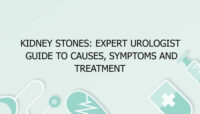Tonsillitis is an infection of the tonsils, the two oval-shaped masses of tissue located at the back of the throat. These glands play a crucial role in the immune system, helping to fight infections by trapping bacteria and viruses that enter through the mouth and nose. While tonsillitis can occur at any age, it is most common in children. This condition can be caused by a variety of factors, including viral and bacterial infections, and it is characterized by a range of symptoms, from a sore throat to fever and difficulty swallowing. Understanding the causes, symptoms, diagnosis, and treatment of tonsillitis is essential for managing the condition and preventing complications.
What is Tonsillitis?
Tonsillitis refers to the inflammation and swelling of the tonsils due to an infection. The condition can develop suddenly and is often accompanied by symptoms such as sore throat, fever, swollen lymph nodes, and difficulty swallowing. Tonsillitis can be caused by viral infections such as the common cold or flu, or by bacterial infections, most commonly caused by Streptococcus pyogenes, the bacteria responsible for strep throat. While tonsillitis is often a self-limiting condition that resolves on its own, severe or recurrent cases may require medical treatment, including antibiotics or, in some instances, surgical intervention.
Types of Tonsillitis
- Acute Tonsillitis: This is a short-term infection, usually lasting for about 7 to 10 days. It is commonly caused by viral infections, though it can also be caused by bacteria. Acute tonsillitis is characterized by sudden onset of symptoms and typically resolves with appropriate treatment.
- Chronic Tonsillitis: Chronic tonsillitis occurs when the tonsils remain persistently inflamed over an extended period. This form of tonsillitis can cause recurring symptoms, including frequent sore throats and infections. Chronic tonsillitis may lead to complications and is often treated with antibiotics or surgical removal of the tonsils (tonsillectomy).
- Recurrent Tonsillitis: Recurrent tonsillitis refers to the frequent recurrence of acute tonsillitis episodes, often more than seven times a year. It can be caused by repeated bacterial infections, and individuals with recurrent tonsillitis may require a tonsillectomy to prevent further infections.
Causes of Tonsillitis
Tonsillitis can be caused by both viral and bacterial infections. Understanding the underlying cause is essential for determining the appropriate treatment.
1. Viral Infections
Viral infections are the most common cause of tonsillitis. Several viruses can lead to tonsil inflammation, including:
- Common Cold Virus: Viruses that cause the common cold, such as rhinoviruses, can lead to mild tonsillitis.
- Influenza (Flu) Virus: The influenza virus can cause more severe tonsillitis, often accompanied by flu-like symptoms such as fever, body aches, and fatigue.
- Adenovirus: This virus is known to cause respiratory infections and can result in tonsillitis, especially in children.
- Epstein-Barr Virus (EBV): EBV is the virus responsible for mononucleosis (mono), and it is a common cause of viral tonsillitis. Symptoms of mono include swollen tonsils, sore throat, fever, and fatigue.
- Herpes Simplex Virus (HSV): HSV, responsible for cold sores, can also cause tonsillitis, though this is less common.
2. Bacterial Infections
Bacterial infections are less common but more severe than viral infections. The most common bacteria that cause tonsillitis include:
- Streptococcus Pyogenes: This bacteria, responsible for strep throat, is the most common bacterial cause of tonsillitis. It can lead to more severe symptoms and complications such as rheumatic fever or kidney inflammation.
- Corynebacterium Diphtheriae: The bacterium that causes diphtheria, though rare, can also lead to tonsillitis and is associated with a characteristic grayish membrane in the throat.
- Neisseria Gonorrhoeae: This bacteria, which causes gonorrhea, can also lead to tonsillitis, although it is less common.
3. Other Factors
In addition to infections, other factors can contribute to the development of tonsillitis:
- Allergies: Allergies to pollen, dust, or pet dander can lead to throat irritation and swelling of the tonsils, though this is usually less severe than an infection.
- Environmental Factors: Exposure to dry air, pollution, or secondhand smoke can irritate the tonsils and contribute to inflammation.
Symptoms of Tonsillitis
The symptoms of tonsillitis can range from mild to severe, depending on whether the cause is viral or bacterial. Common symptoms of tonsillitis include:
1. Sore Throat
A sore throat is the most common symptom of tonsillitis. It may start as a mild scratchy feeling but can progress to severe pain when swallowing. In some cases, the pain may extend to the ears due to the shared nerve pathways.
2. Difficulty Swallowing
Swelling and inflammation of the tonsils can make it painful or difficult to swallow. This may lead to discomfort when eating or drinking.
3. Fever
Fever is a common symptom of tonsillitis, especially when the infection is bacterial. A fever may range from mild to high, and it is often accompanied by chills and body aches.
4. Swollen Tonsils and Lymph Nodes
The tonsils may appear red, swollen, and covered in white or yellow patches of pus. The lymph nodes in the neck may also become swollen and tender as the body responds to the infection.
5. Bad Breath
Tonsillitis can cause bad breath (halitosis) due to the accumulation of bacteria or pus in the tonsils.
6. Headache and Fatigue
Many people with tonsillitis experience headaches and a general feeling of fatigue. The body’s immune response to the infection can lead to a sense of overall malaise.
7. Ear Pain
Pain in the ears is common with tonsillitis, particularly if the infection is caused by streptococcal bacteria. This is due to the shared nerve pathways between the ear and the throat.
8. Rash (In Some Cases)
In some cases, especially with bacterial tonsillitis caused by streptococcus, a red rash may appear on the body, known as scarlet fever.
Diagnosis of Tonsillitis
To diagnose tonsillitis, a healthcare provider will typically conduct a physical examination and ask about the symptoms. The following steps are often involved in the diagnostic process:
1. Physical Examination
During the physical examination, the healthcare provider will inspect the throat for signs of inflammation, redness, and the presence of pus or white patches on the tonsils. Swelling of the lymph nodes in the neck will also be assessed.
2. Throat Swab and Culture
If a bacterial infection is suspected, the healthcare provider may perform a throat swab to collect a sample from the tonsils. The sample is sent to a laboratory for culture to identify whether bacteria, such as Streptococcus pyogenes, are present.
3. Rapid Strep Test
In some cases, a rapid strep test may be performed to quickly determine if the tonsillitis is caused by streptococcal bacteria. The results are available within minutes, helping guide treatment decisions.
4. Blood Tests
Blood tests may be conducted if the healthcare provider suspects a viral infection such as mononucleosis. An elevated white blood cell count or the presence of specific antibodies may help identify the cause.
5. Imaging
In rare cases, imaging tests such as X-rays may be used if there are concerns about complications like an abscess or a blocked airway.
Treatment of Tonsillitis
The treatment for tonsillitis depends on the underlying cause—whether it is viral or bacterial—and the severity of the condition.
1. Viral Tonsillitis
Viral tonsillitis generally resolves on its own without the need for antibiotics. The treatment for viral tonsillitis focuses on managing symptoms and providing comfort. Common approaches include:
- Rest and Hydration: Getting plenty of rest and drinking fluids helps the body recover from the infection.
- Pain Relief: Over-the-counter pain relievers, such as ibuprofen or acetaminophen, can help alleviate sore throat pain and reduce fever.
- Throat Lozenges: Lozenges or gargling with salt water can help soothe a sore throat.
- Humidifiers: Using a humidifier in the room can keep the air moist and reduce throat irritation.
2. Bacterial Tonsillitis
Bacterial tonsillitis, particularly caused by streptococcus, requires treatment with antibiotics to prevent complications such as rheumatic fever or kidney disease. The treatment plan may include:
- Antibiotics: Oral antibiotics, such as penicillin or amoxicillin, are commonly prescribed to treat bacterial tonsillitis. It is essential to complete the entire course of antibiotics to ensure the infection is fully eradicated.
- Pain Relief: Like viral tonsillitis, pain relievers such as acetaminophen or ibuprofen can help manage pain and fever.
- Rest and Hydration: Adequate rest and fluids are important to support the body’s healing process.
3. Surgical Treatment
In cases of chronic or recurrent tonsillitis, or if there are complications such as abscess formation, a tonsillectomy (surgical removal of the tonsils) may be recommended. Tonsillectomy is considered when:
- Tonsillitis recurs frequently despite treatment.
- The tonsils cause significant breathing problems, such as obstructive sleep apnea.
- Abscess formation occurs around the tonsils (peritonsillar abscess).
4. Home Remedies and Supportive Care
In addition to medical treatment, several home remedies and supportive measures can help alleviate symptoms of tonsillitis, including:
- Drinking warm teas with honey to soothe the throat.
- Avoiding irritants such as smoke or dry air.
- Using lozenges, throat sprays, or saltwater gargles for pain relief.
FAQ’s About Tonsillitis
What are the main causes of tonsillitis?
Tonsillitis is primarily caused by infections, both viral and bacterial. Common viruses include the flu, common cold, and Epstein-Barr virus (which causes mononucleosis). The most common bacterial cause is Streptococcus pyogenes, responsible for strep throat. Other causes can include allergies or irritants like smoke.
How do I know if I have viral or bacterial tonsillitis?
While both viral and bacterial tonsillitis share similar symptoms, bacterial tonsillitis tends to be more severe, with higher fever, swollen lymph nodes, and white patches on the tonsils. A throat swab and rapid strep test are often used to differentiate between viral and bacterial infections.
Can tonsillitis be prevented?
Tonsillitis cannot always be prevented, but several measures can reduce the risk of infection. Regular handwashing, avoiding close contact with infected individuals, and practicing good hygiene can help prevent the spread of infections. Additionally, avoiding smoking and environmental irritants can reduce the risk of tonsil inflammation.
How long does it take to recover from tonsillitis?
The recovery time for tonsillitis depends on whether it is viral or bacterial. Viral tonsillitis typically improves within a few days to a week with supportive care. Bacterial tonsillitis, when treated with antibiotics, usually resolves within 10 days. Severe or recurrent cases may require longer recovery or surgery.
Is tonsillitis contagious?
Yes, tonsillitis can be contagious, especially if caused by bacterial infections such as strep throat. The infection can spread through respiratory droplets when an infected person coughs, sneezes, or shares utensils. Practicing good hygiene and avoiding close contact with infected individuals can help prevent transmission.
Can tonsillitis lead to complications?
If left untreated, bacterial tonsillitis can lead to complications such as abscess formation, rheumatic fever, or kidney problems. Recurrent tonsillitis can also result in chronic inflammation, and in some cases, tonsillectomy may be necessary.
What is a tonsillectomy, and when is it needed?
A tonsillectomy is a surgical procedure to remove the tonsils. It is usually recommended for individuals with chronic or recurrent tonsillitis that does not respond to treatment or those who experience complications such as obstructive sleep apnea. The decision to perform a tonsillectomy is made based on the frequency and severity of tonsillitis.
Can I still eat if I have tonsillitis?
It may be painful to eat while suffering from tonsillitis, but it is important to stay hydrated and nourished. Soft foods such as soups, smoothies, and yogurt are easier to swallow. Drinking warm tea with honey or consuming popsicles can also help soothe the throat.
Are there natural remedies for tonsillitis?
While antibiotics are required for bacterial tonsillitis, several natural remedies can help alleviate the symptoms of both viral and bacterial tonsillitis. Gargling with saltwater, drinking warm herbal teas with honey, and using throat lozenges can provide relief from pain and irritation.
Is tonsillitis common in children?
Yes, tonsillitis is most common in children, although it can affect people of all ages. Children are more susceptible due to their developing immune systems. Recurrent infections are more common in children, and they may require antibiotics or, in severe cases, a tonsillectomy.


